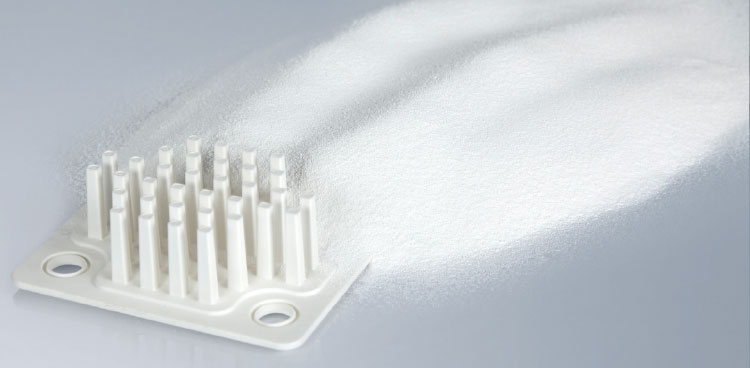Ceramics – a fresh take on electronics design
Plastics made thermally conductive through ceramic additives – a revolution for power electronics

Thermal interface material (TIM)
Power electronics, sensors, modern LED lighting, smartphones, drive components in cars or machines and much more – the heat generated in these devices with high power density is generally considered a critical threat to their function and must be dissipated. However, heat management poses a complex challenge, because compact design and trends in component miniaturization alongside lightweight construction are not compatible with the use of conventional heat-insulating plastics.
High-performance electronic components, for example, are often fitted with extra fans and comparatively large heat sinks of aluminum or copper in order to efficiently counteract unwanted temperature increases. But because these metals conduct not only heat but also electricity, electrical insulation must also be ensured through means of suitable thermal interface materials. Despite optimized heat sink and housing designs, this remains a constructional dilemma. Thermally conductive plastics now offer us a solution – or more specifically, thermally conductive ceramics used as an additive in plastics.
Ultra-light electronics design thanks to technical ceramics
Thermally conductive plastics represent a paradigm shift in materials and have paved the way for an entirely fresh take on electronics design. On the one hand, they offer the significant advantages of thermoplastic materials – lightweight construction, cost-effective mass production, electrical insulation and the capacity to be manufactured into almost any shape. On the other hand, their heat-dissipating properties mean that they can also be used to make housings and heat sinks. This opens up further construction and design options for the design engineer. For example, complex electronic components can now be over molded with thermally conductive plastics – and the conventional cooling fin structures can then at the same time serve as the housing.
Boron nitride makes plastics thermally conductive
The ceramic aggregate boron nitride is one such substance that’s used as a filler for plastic compounds. The thermal conductivity of boron nitride is comparable with that of silver (430 W/mK) and copper (380 W/mK), with the thermal conductivity of boron nitride single crystals being approx. 400 W/mK in-plane.
Depending on the fill level and type of plastic, 15 W/mK can be achieved with boron nitride when combined with plastics – while the plastic retains its electric insulation properties. Hexagonal boron nitride (hBN) has a very low density of 2.26 g/cm³. The low coefficient of thermal expansion and high modulus of elasticity ensure the best possible dimensional stability, even with large components.
Boron nitride is available in a variety of qualities that differ in particle-size distribution, tap density, surface, purity and many other parameters. This makes it possible to create bespoke plastic mixtures that meet the most diverse requirements for the manufacturing process or the properties of the product.
Advantages of hexagonal boron nitride
- High thermal conductivity – up to 400 W/mK for hBN
- Good sliding friction, meaning less wear and tear on injection molding and press systems
- For large flow rates in high-volume operations
- Low density enables low component weight
- Low coefficient of thermal expansion and high modulus of elasticity
- White – gives plastics a clean appearance
Thermally conductive plastics with boron nitride additives offer electric insulation and high thermal conductivity and can replace metals as well as hybrid and composite materials. Typical applications include PCB heat sinks, hose material for heat exchangers in household technology, insulating material for machine components that move at high speeds, heat sink housings for LED lights, engine parts and electronic components in vehicles.
Hollow glass bubbles as lightweight fillers - does this interest you?

The right additive intelligently selected for the base material creates real added value in product development.
- Weight reduction
- Thermal insulation
- Recyclability
The outstanding properties of 3M™ Glass Bubbles enable a wide range of applications.
Learn more about using hollow glass microspheres as lightweight fillers.
Find out more and get in touch with us: 3M Glass Bubbles
Please click here for the Product catalogue

